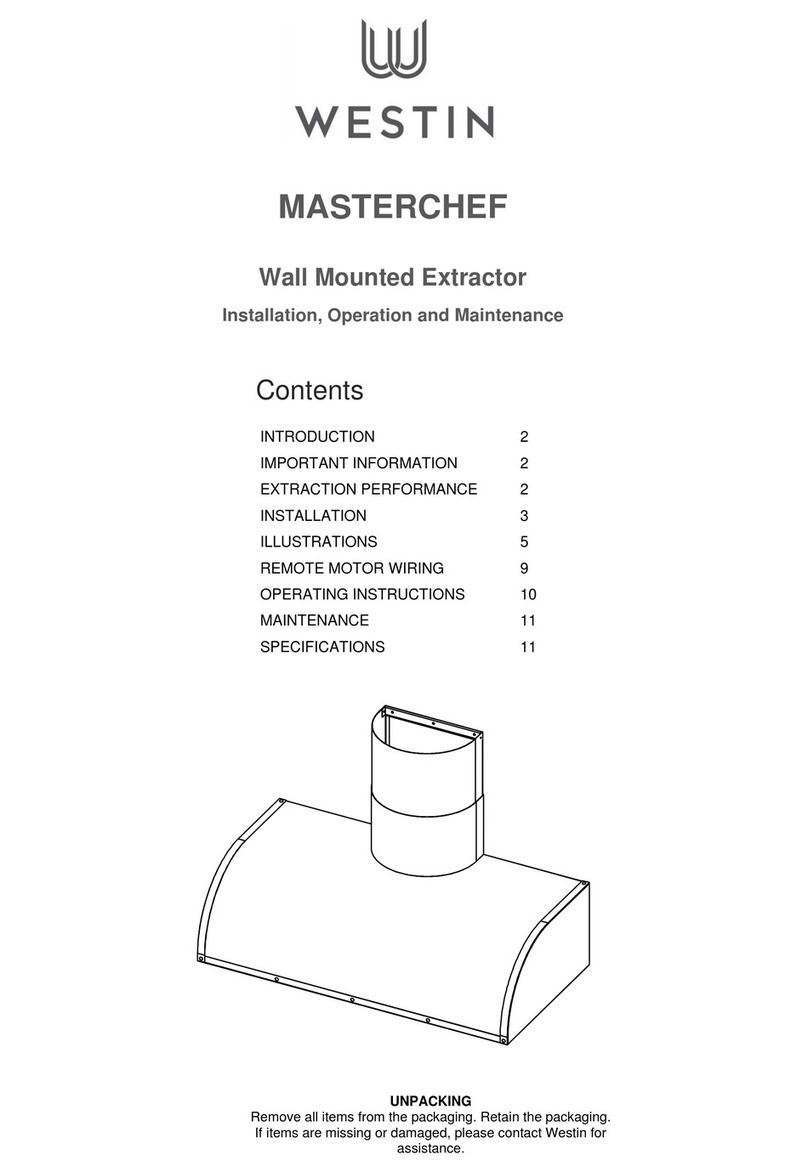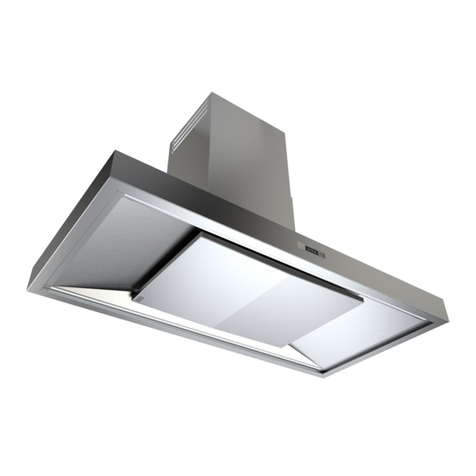Note: To avoid the need to box down from the ceiling, consider the
joist direction, ceiling thickness (and possibly lowering the ceiling
slightly). As much of the baseplate only intrudes above the finished
ceiling by 25mm, (see diagrams on Page 7 Onwards) boxing down
can usually be avoided with minimal alterations to the ceiling
arrangement.
Ducting
Install ducting taking note of the advice given in section 2 & 3.
We recommend using semi-rigid round ducting for this extractor –
the initial connection to the extractor spigot must be in semi-rigid
(or flexible duct) to allow the entire unit (or top box if fitting
separately) to be pushed into position with the duct connected.
Run the ducting such that there is enough to easily reach just
beyond the centre point of the extractor, thus allowing for a short
length to be pulled through the opening for later connection to the
top box spigot. Try to avoid tight bends immediately adjacent to
where the top box will be as this will make pushing the unit/top box
into position more difficult.
When terminating ducting on an outside wall, a suitable weather
louvre should be fitted. Various ducting components and complete
kits are available from Westin to suit most installations.
If you plan to use expanding foam, make sure that any soft flexible
ducting is supported internally to prevent it crushing, or use semi-
rigid/rigid ducting where foam is used.
For roof or chimney duct terminations, please contact Westin, or
seek alternative specialist advice.
If you are fitting a wall-mounted external motor with semi-rigid or
flexible ducting, then you must leave a short length (approx.
200mm) of expanded (stretched out) ducting proud of the wall (to
facilitate connection to the motor spigot) before pushing both into
position flush with the wall.
Standard external motors come with a cable assembly and fitted
plugs that must pass through the wall and run back to the extractor
–usually this passes alongside the ducting so it is recommended
to oversize your cut-out by at least 25mm to allow for this (and for
the easy installation of the duct).
Remote External Wall and Inline Motors
If your extractor has been purchased to operate with a standard
inline or external remote motor (SEM), then you will find a black
plastic box outside the extractor (on flying leads) containing
electrical terminals for connection to the remote motor cable
assembly. This box is referred to as the remote motor terminal box.
Run the remote motor cable such that sufficient hangs down
through the ceiling opening prepared for the extractor to allow for
easy connection to the remote motor terminal box.
Each terminal inside the remote motor terminal box has one side
connected to a coloured wire, which leads back to the hood control
system. The remote motor cable assembly also has coloured wires
and these are connected to the empty terminals. Such
corresponding colours are opposite and connect to each other; i.e.
red connects to red, blue to blue, and so on.
Not all terminals will be used because each remote motor type is
configured differently.
No separate power supply is required for the external motor.
An electrician (or Part P registered electrical installer) should
undertake any work associated with the electrical installation of
SEM remote motors.
Please refer to the REMOTE MOTOR ILLUSTRATIONS on
page 9 for more information.
If you need to extend the remote motor cable, then additional
cable can be purchased from Westin. Alternatively, it may be
extended using 7 core x 0.5mm flex. It is vital to ensure that any
new cable is inserted such that the core colour integrity is
maintained; i.e. a core that started as red must terminate as
red, blue as blue, purple as purple, and so on.
Any remote motor should be installed in accordance with the
installation instructions that accompany it. It must be installed
in an easily accessible location for future maintenance. Westin
are not responsible for providing the means of access (e.g.
scaffolding or any alterations to the building and/or furniture
necessary to make access possible) in the event of any
maintenance requirement.
Electrical Installation
The extractor is a fixed electrical appliance and must have a
provision for isolating the electrical supply via its own switched-
fused spur located in an accessible position within the kitchen.
A qualified electrical technician must perform the installation of
the electrical supply to the extractor.
The extractor must befed froma 230Vac single phase electrical
supply using a switched spur fitted with a 3A fuse. The switch
should be located so that the supply can be disconnected from
the extractor using the switch at any time following installation
–the switch must be accessible. The means of disconnection
from the supply must have a minimum contact separation of
3mm in all poles. Alternatively, a means of disconnection in the
fixed wiring according to the relevant wiring rules must be fitted.
A supply cord for connecting the extractor to the spur is
included. The mains supply is connected to the free end of this
cord as follows:




































